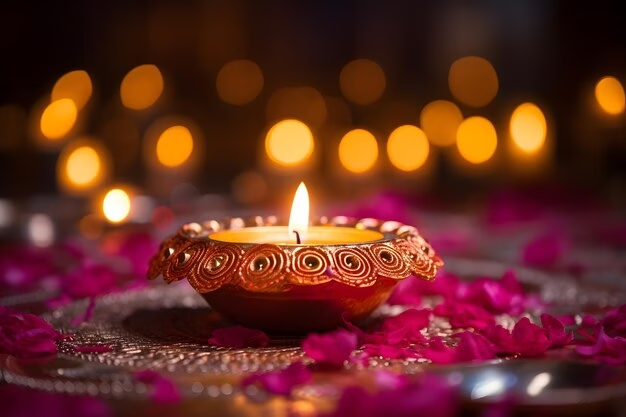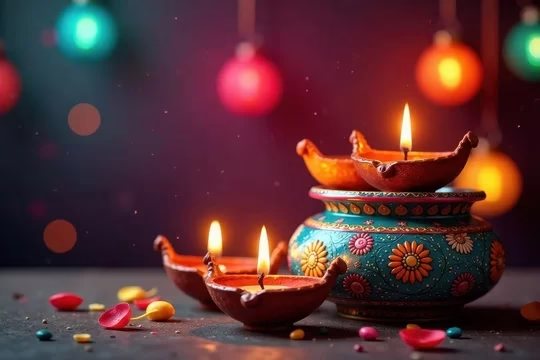
Introduction
The daily practice of pooja, a sacred ritual in Hinduism, involves invoking divine energies and fostering a deeper connection with the spiritual realm. Among the various elements used in pooja, the lighting of a lamp holds significant importance, symbolizing the dispelling of darkness and the welcoming of light and positivity.
While various types of fuels and wicks can be used, ghee diyaa are considered particularly auspicious and beneficial, both from a spiritual and a scientific perspective. Let’s delve into the profound reasons why ghee diyaa are essential for your daily pooja rituals.
The Sacred Significance of Ghee Diyaa in Pooja
Ghee, or clarified butter, has been revered in Indian culture for centuries. It is not merely a cooking ingredient but holds a sacred status, often used in religious ceremonies and considered pure and sattvic (promoting purity and balance). Its association with divinity stems from ancient Vedic texts, where ghee is frequently mentioned as an offering to the gods and a symbol of nourishment and auspiciousness.
The act of lighting a ghee lamp during pooja is believed to invite prosperity, wisdom, and good health into the household. The gentle, golden flame of a ghee wick is seen as an embodiment of the divine light, illuminating the path towards spiritual growth and inner peace. The aroma emanating from a burning ghee wick is also considered sacred, purifying the atmosphere and creating a conducive environment for prayer and meditation.
Spiritual Benefits of Using Ghee Diyaa
Using ghee diyaa in your daily pooja rituals carries a multitude of spiritual benefits that resonate deeply with the core principles of Hindu philosophy. These benefits extend beyond the mere act of lighting a lamp, influencing the energy of your surroundings and your inner consciousness.
Invoking Divine Blessings and Prosperity
Lighting a ghee lamp is traditionally believed to attract the blessings of Lakshmi, the goddess of wealth and prosperity. The pure nature of ghee is considered highly pleasing to her, and offering light with ghee diyaa is seen as a way to invite abundance and financial well-being into your life. This practice is not just about material wealth but also encompasses spiritual richness and overall well-being.
Enhancing Concentration and Meditation
The soft, steady flame of a ghee wick creates a serene and focused ambiance, ideal for meditation and prayer. Unlike the flickering or smoky flame of some oil lamps, the gentle glow of ghee helps to calm the mind, reduce distractions, and enhance concentration. This focused environment allows for a deeper connection with the divine and facilitates a more meaningful spiritual experience during your pooja.
Purifying the Environment and Negating Negative Energies
The burning of ghee is believed to have a purifying effect on the surrounding environment. It is said to release sattvic vibrations that help to dispel negative energies and create a positive and harmonious atmosphere. This purification extends beyond the physical realm, influencing the subtle energies of your home and promoting a sense of peace and tranquility.
Symbolizing the Victory of Light Over Darkness
The act of lighting any lamp in pooja symbolizes the triumph of light over darkness, knowledge over ignorance, and good over evil. When a ghee wick is used, this symbolism is amplified due to the inherent purity and sacredness of ghee. The radiant flame serves as a constant reminder of the inner light that resides within us and the potential to overcome negativity through spiritual practices.
Scientific Insights into the Benefits of Ghee Diyaa

Beyond the spiritual significance, there are also scientific reasons that support the use of ghee diyaa in pooja. While modern scientific research in this specific area is still evolving, traditional knowledge and some preliminary studies offer interesting insights into the properties of burning ghee.
Emission of Beneficial Aromas and Compounds
When ghee is burned, it releases a subtle and pleasant aroma that is considered beneficial. Traditional Ayurvedic texts suggest that the fumes from burning ghee can have a positive impact on the mind and body. Some believe that these fumes may possess mild antiseptic and air-purifying properties, contributing to a healthier environment during pooja.
Softer and Cleaner Flame Compared to Some Oils
Compared to certain types of oils, ghee tends to produce a softer and cleaner flame with less soot and smoke. This is particularly important for maintaining a clean and healthy indoor environment, especially during prolonged pooja rituals. The reduced smoke also ensures that the sacred images and idols in your pooja space remain clean and untarnished.
Potential for Longer Burning Time
Ghee, depending on its quality and the wick used, can sometimes offer a longer burning time compared to some thinner oils. This allows for a more sustained illumination during your pooja, without the need for frequent replacements or interruptions. A steady flame contributes to a more focused and uninterrupted spiritual practice.
Why Ghee Diyaa Are Superior to Oil Wicks in Pooja Rituals
While oil wicks are also commonly used in pooja, ghee diyaa for daily pooja are often considered superior due to a combination of spiritual and practical reasons. The unique properties of ghee elevate its significance in these sacred rituals.
Enhanced Spiritual Vibrations
As mentioned earlier, ghee is considered highly sattvic and pure. When burned, it is believed to emit more potent and positive spiritual vibrations compared to most oils. This enhanced energy can contribute to a deeper and more transformative pooja experience, fostering a stronger connection with the divine.
More Auspicious and Traditionally Preferred
Historically and traditionally, ghee has held a more auspicious status in Hindu rituals compared to many common oils. Ancient texts and practices often emphasize the use of ghee for lighting lamps during sacred ceremonies. This traditional preference carries a cultural and spiritual weight that many devotees continue to honor.
Cleaner Burning and Pleasant Aroma
Ghee generally burns cleaner than some vegetable oils, producing less soot and a more pleasant aroma. This contributes to a more serene and pure atmosphere in your pooja room, enhancing the overall spiritual experience. The gentle fragrance of burning ghee is often associated with sanctity and positivity.
Symbolism of Purity and Nourishment
Ghee, being a product derived from milk, symbolizes purity, nourishment, and sustenance. Offering light with a ghee wick is therefore seen as offering these essential qualities to the divine. This symbolism adds another layer of depth and meaning to the ritual, making it more spiritually enriching.
Practical Tips for Using Ghee Diyaa in Daily Pooja
To maximize the benefits of using ghee diyaa in your daily pooja, here are some practical tips to keep in mind:
Choose Pure and High-Quality Ghee
Opt for pure, cow-based ghee whenever possible. The quality of the ghee can influence the purity of the flame and the aroma produced. Avoid ghee that contains additives or impurities, as these can detract from the spiritual benefits.
Select the Right Type of Diyaa
Cotton wicks are commonly used for ghee lamps. Ensure the wick is of appropriate thickness and length for your lamp. You can also shape the wick into different forms, such as a single strand or multiple strands twisted together, depending on your preference and the desired size of the flame.
Prepare the Lamp and Wick Properly
Before lighting the lamp, ensure it is clean and dry. Dip the base of the cotton wick into the ghee, allowing it to absorb some of the fuel. Leave a portion of the wick above the ghee to be lit.
Maintain a Safe and Reverent Environment
Place the ghee lamp in a safe location away from flammable materials. Maintain a reverent attitude while lighting the lamp and during the pooja. Focus your intentions and prayers as the flame illuminates your sacred space.
Observe the Flame and Aroma
Pay attention to the flame of the ghee diyaa. A steady, golden flame is considered auspicious. Inhale the gentle aroma and allow it to create a peaceful and focused state of mind.
Conclusion
Incorporating ghee diyaa into your daily pooja rituals offers a multitude of spiritual and practical benefits. From invoking divine blessings and purifying the environment to creating a serene atmosphere for meditation, the use of ghee enhances the sacredness and efficacy of your prayers.
While oil wicks serve their purpose, the purity, auspiciousness, and subtle advantages of ghee make it a preferred choice for those seeking a deeper and more meaningful connection with the divine. By embracing the light of ghee, you not only illuminate your pooja space but also invite positivity, prosperity, and spiritual growth into your life. Make ghee diyaa an essential part of your daily pooja and experience the transformative power of this ancient tradition.
FAQs
1: Can I use any type of ghee for pooja?
: Cow ghee is preferred for its purity and sacredness; use only pure, additive-free ghee.
2: How long should a ghee wick burn during pooja?
: It should burn for the duration of the pooja; adjust ghee and wick size as needed.
3: Can I reuse ghee after it has been used in a pooja lamp?
: No, it’s sacred and should be disposed of respectfully, not reused for cooking.
4: Are there any specific shapes or types of ghee diyaa that are more auspicious?
: Shapes like V or multiple strands are used, but intention and devotion matter most.
5: What if I don’t have access to ghee? Can I use oil wicks instead?
: Yes, oils like sesame, coconut, or mustard are fine; devotion is key.
6: How do I clean a ghee lamp after use?
: Let it cool, then wash with mild soap and water; use lemon and salt for brass or silver.
